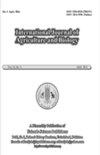Broccoli Seedling Production in Response to Recognised Organic Inputs
Q2 Agricultural and Biological Sciences
引用次数: 1
Abstract
This study evaluated the production of seedlings broccoli (Brassica oleracea var. Italica) with organic inputs. The inputs were as follows; a) growth medium, consisting of Sphagnum peat (Pro Moss TBK®) mixed with poultry manure compost (Vertia® brand) in a) 90:10 and 80:20 ratios; b) biofungicide Trichoderma harzianum Rifai (Natucontrol® brand) at doses of 1.5 and 3 g/L water per 338-cavity polystyrene tray; and c) complementary nutrition applied in irrigation with poultry manure tea at doses of 0.5 and 1 dS/m per tray every two days. Control set was a ‘typical management’ control based on peat (100%) as a growing medium with the application of conventional fertiliser (1 g/L of Tricel® 20 every two days) and conventional fungicide Mancozeb as a damping-off preventative (1 g/L per tray). The seedling growth, relative chlorophyll content, photosystem II quantum yield, and morphological indicators showed that the eight treatments with recognised organic inputs performed significantly better than the control (p<0.05). The use of peat substrate mixed with poultry manure (80:20 ratio) with inoculation of T. harzianum at a dose of 1.5–3 g/L and with application of poultry manure tea at a dose of 1 dS/m yielded the best results. We determined that it is possible to obtain quality broccoli seedlings with the inputs recognised for certified organic agriculture. © 2021 Friends Science Publishers响应公认的有机输入的西兰花幼苗生产
本研究评价了有机投入下花椰菜(Brassica oleracea var.Italica)幼苗的生产。投入如下:;a) 生长培养基,由泥炭泥炭(Pro Moss TBK®)与家禽粪便堆肥(Vertia®品牌)以a)90:10和80:20的比例混合而成;b) 生物絮凝剂哈茨木霉Rifai(Natucontrol®品牌),剂量为每338腔聚苯乙烯托盘1.5和3 g/L水;和c)以每托盘每两天0.5和1dS/m的剂量在家禽粪便茶灌溉中施用的补充营养。对照组是一种“典型管理”对照,以泥炭(100%)为生长介质,施用常规化肥(每两天1 g/L Tricel®20)和常规杀菌剂Mancozeb作为阻尼预防剂(每托盘1 g/L)。幼苗生长、相对叶绿素含量、光系统II量子产量,形态学指标显示,8个有机输入处理的效果明显好于对照(p<0.05)。使用泥炭基质与家禽粪便(80:20比例)混合,接种1.5–3 g/L的哈茨霉,并施用1 dS/m的家禽粪便茶,效果最好。我们确定,通过认证有机农业的投入,可以获得高质量的西兰花幼苗。©2021 Friends Science出版社
本文章由计算机程序翻译,如有差异,请以英文原文为准。
求助全文
约1分钟内获得全文
求助全文
来源期刊

International Journal of Agriculture and Biology
AGRICULTURE, MULTIDISCIPLINARY-
CiteScore
1.70
自引率
0.00%
发文量
40
审稿时长
5 months
期刊介绍:
Information not localized
 求助内容:
求助内容: 应助结果提醒方式:
应助结果提醒方式:


